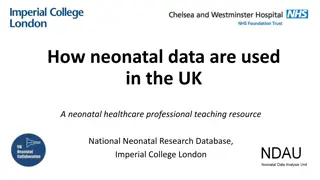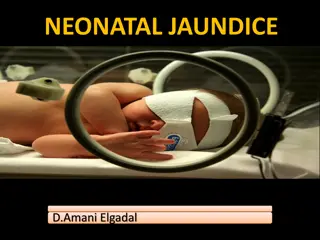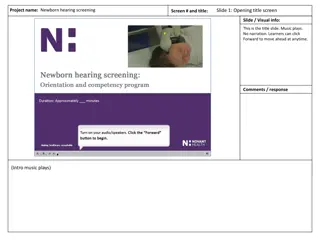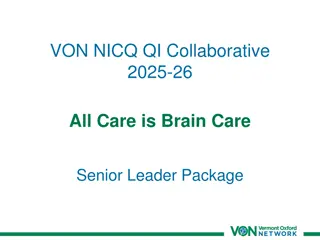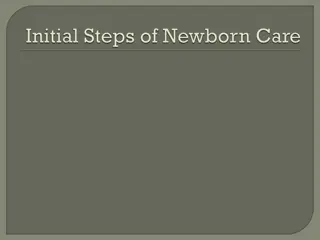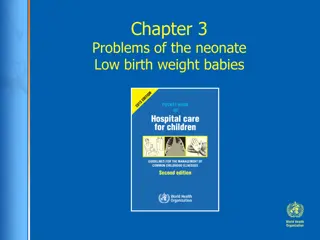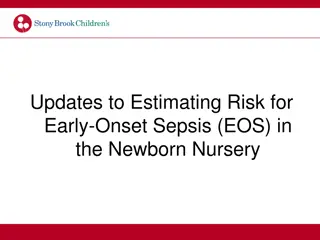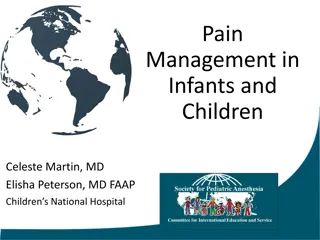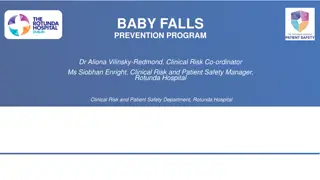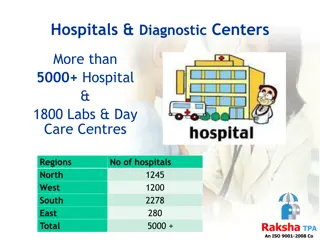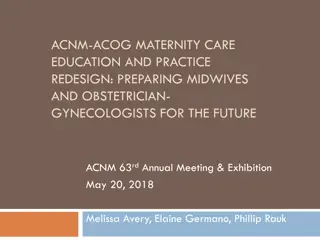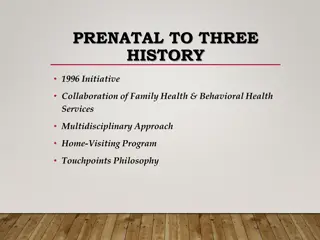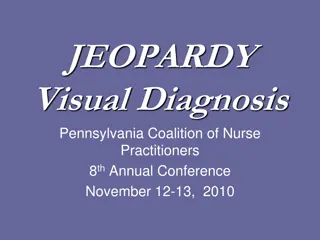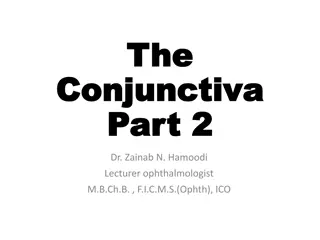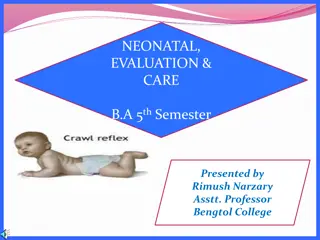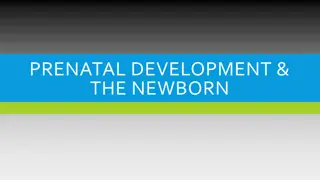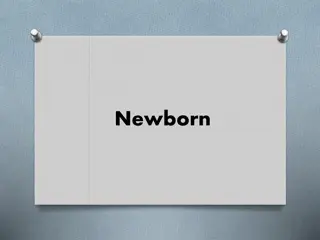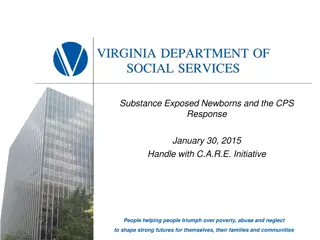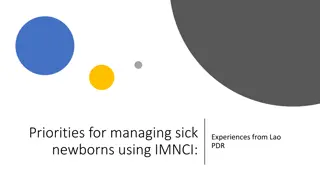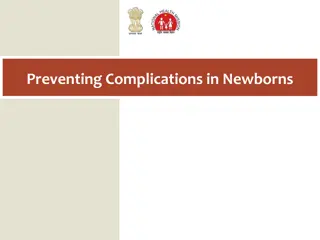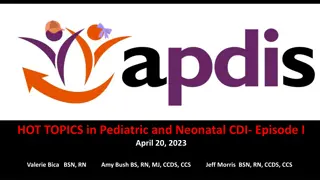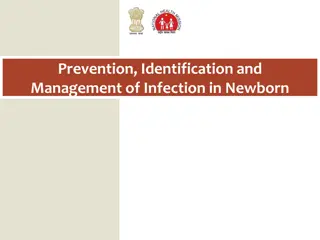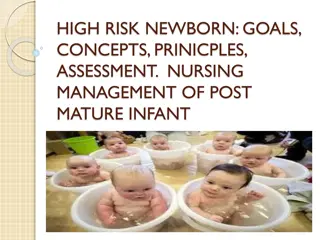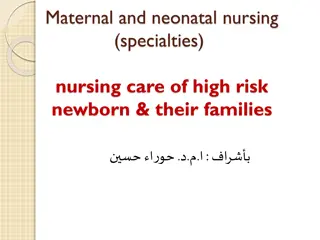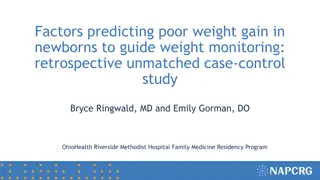Understanding Newborn Screening in Oklahoma
Newborn screening in Oklahoma is crucial for detecting hidden disorders in newborns that may not be apparent at birth. Early detection through screening can lead to timely treatment, ensuring healthy development and potentially saving lives. The process involves testing every newborn for harmful con
1 views • 88 slides
Understanding Neonatal Data Usage in the UK Healthcare System
Neonatal data plays a crucial role in assessing the quality of care provided to newborns in the UK. This resource from the National Neonatal Research Database at Imperial College London sheds light on how neonatal data is collected, utilized, and shared among healthcare professionals. The importance
1 views • 24 slides
NEONATAL JAUNDICE
Neonatal jaundice, a common condition in newborns, results from elevated bilirubin levels. While often benign, high levels can lead to complications like kernicterus. Recognizing risk factors, limitations of clinical assessment, and appropriate evaluation and treatment are crucial in managing neonat
1 views • 48 slides
Understanding the Measurement Trends and Data Gaps in Low Birthweight Worldwide
Explore the challenges and progress in measuring, understanding, and addressing low birthweight (LBW) in newborns globally. The data reveals significant gaps in LBW data collection and highlights the need for focused efforts to reduce LBW rates and improve newborn health outcomes.
3 views • 19 slides
Newborn Hearing Screening Program Overview
The Newborn Hearing Screening Project aims to educate healthcare professionals on the importance of early identification of hearing loss in infants. The program discusses the significance of timely intervention, the impact of undetected hearing loss on child development, and provides guidelines for
0 views • 15 slides
Understanding Bilirubin: What You Need to Know
Bilirubin is a yellowish substance formed during the breakdown of red blood cells, traveling through the liver before excretion. High levels indicate hyperbilirubinemia, often signaling underlying health issues. It's a common occurrence in newborns as well. The compound plays a crucial role in the b
0 views • 19 slides
VON.NICQ.QI Collaborative 2025-26: All Care is Brain Care Senior Leader Package
Vermont Oxford Network is a non-profit collaborative with over 30 years of neonatal quality improvement experience. Their project focuses on neuroprotective care for newborns to ensure optimal development. The initiative includes small group collaborations, customized benchmarked data reports, and f
0 views • 15 slides
Expanded Safe Sleep Policy Implementation
The safe sleep policy is being updated to encompass teaching for all patients less than 12 months old rather than solely focusing on newborns at birth. This change emphasizes the shared responsibility of ensuring patient safety among all staff members. If you have any uncertainties about the new pol
0 views • 6 slides
Understanding the Organization of NICU: A Comprehensive Guide
The organization of a Neonatal Intensive Care Unit (NICU) plays a vital role in reducing neonatal mortality and improving the quality of life for newborns. This comprehensive guide covers the objectives, definition, basic facilities, levels of care, and components of a NICU. It emphasizes the import
0 views • 60 slides
Newborn Infant Physical Examination (NIPE) and Neonatal Checks Overview
Essential information on the NIPE screening update, neonatal checks, learning outcomes, eye examination, heart and CVS examination, and hips assessment for newborns. This content emphasizes early identification of abnormalities, top-to-toe examination, referral guidelines, and critical assessments t
0 views • 11 slides
Rapid Assessment of Newborn Care: Essential Steps and Interventions
Detailed information on the initial steps of newborn care, including assessing the need for additional interventions, managing conditions like persistent cyanosis and labored breathing, using a Pulse Oximeter, providing supplemental oxygen, and when to consider Positive Pressure Ventilation. Practic
0 views • 27 slides
Importance of Monitoring Vitals for Mother and Newborn
Monitoring vital signs such as temperature, pulse, respiratory rate, and blood pressure is crucial for detecting various conditions in mothers and newborns. Understanding the significance of tracking these vital signs helps healthcare providers assess the well-being of both the mother and the baby,
0 views • 5 slides
Management of Low Birth Weight Neonate: Baby Jonah Case Study Emergency Measures
Baby Jonah, born at 30 weeks gestation with low birth weight, exhibits emergency signs such as slow respiration and apnoea. The case highlights the importance of triage, emergency treatment, history and examination, laboratory investigations, diagnosis, treatment, supportive care, monitoring, discha
1 views • 27 slides
Neonatal Care at Lagos University Teaching Hospital (LUTH)
Lagos University Teaching Hospital (LUTH) is a tertiary referral center providing comprehensive neonatal care services. The facility has specialized units for inborn and outborn babies, offering advanced medical care, including neonatologists, resident doctors, nurses, and support staff. LUTH also h
0 views • 15 slides
Understanding Early-Onset Sepsis (EOS) Risk Factors and Management in Newborns
Neonatal Early-Onset Sepsis (EOS) is a rare but life-threatening condition primarily caused by Group B Streptococcus (GBS) or Escherichia coli. Recognizing risk factors such as maternal age, intrapartum fever, GBS colonization, and certain neonatal characteristics is crucial for timely evaluation an
0 views • 26 slides
Understanding Pediatric Pain Management
Explore the complexities of managing pain in infants and children, including defining pain, classifying different types of pain, understanding pain assessment tools, identifying medication classes for treatment, and recognizing special considerations. Discover insights on acute and chronic pain, neu
1 views • 40 slides
Baby Falls Prevention Program at Rotunda Hospital
The Baby Falls Prevention Program at Rotunda Hospital aims to reduce the incidence of postpartum neonatal falls, which can cause serious harm to newborns. By increasing staff awareness, educating parents, and introducing safer adult beds and neonatal cots, the program seeks to mitigate the risk of h
0 views • 4 slides
Understanding Rh Immunization and Blood Group Incompatibility
Rh immunization and blood group incompatibility can lead to serious complications in fetuses and newborns. The ABO and Rhesus systems play crucial roles in determining blood group compatibility. Rh-positive red cells of the fetus entering the maternal circulation can trigger immune responses, leadin
0 views • 65 slides
Comprehensive Health Coverage Scheme Details
This comprehensive health coverage scheme provides a sum insured of Rs. 100,000, covering pre-existing illnesses, day-one coverage for new students and newborns, and reimbursement for pre and post-hospitalization expenses. Chronic diseases like asthma and arthritis are covered, along with psychiatri
0 views • 19 slides
Addressing Maternity Care Workforce Shortages: A Focus on Interprofessional Education
Explore the challenges and solutions regarding the projected maternity care workforce shortage in the US. Delve into the importance of interprofessional education for midwifery students and OB-GYN residents, as highlighted in the ACNM-ACOG initiatives. Discover the critical need for change in matern
0 views • 42 slides
Prenatal to Three History and Services Overview
The Prenatal to Three (PTT) initiative, established in 1996, focuses on a collaborative approach between family health and behavioral health services through a home-visiting program based on the Touchpoints philosophy. The program serves adult clients who are pregnant or within 12 months postpartum,
0 views • 22 slides
Seattle Newborn Photographer - Amaris Kristina Photography
Amaris Kristina Photography specializes in capturing the precious moments of newborns in Seattle. With a warm, natural style, Seattle Newborn Photographer creates timeless images that celebrate your baby's first days. Book a session to cherish these
1 views • 5 slides
Understanding Listeria Monocytogenes Infections
Listeria monocytogenes is a bacterium that infects humans, especially pregnant women, newborns, and immunocompromised individuals. It can be differentiated from other bacteria based on its morphology, culture characteristics, and biochemical tests. This summary covers important aspects such as its g
0 views • 14 slides
Pediatric Dermatology Guide for Nurse Practitioners
Explore visual diagnosis challenges from the Pennsylvania Coalition of Nurse Practitioners' annual conference in 2010, covering topics such as neonatal acne, seborrheic dermatitis, and eczema/atopic dermatitis in infants. Enhance your knowledge on common skin conditions affecting newborns and learn
0 views • 63 slides
Overview of Conjunctival Diseases and Their Management
Ophthalmia neonatorum is conjunctival inflammation in newborns, while allergic conjunctival diseases like seasonal and perennial conjunctivitis present with redness, itching, and watering. Vernal keratoconjunctivitis (VKC) is a recurrent condition commonly seen in warm climates, with symptoms like i
0 views • 17 slides
Understanding the Neonatal Period: Care and Evaluation
The neonatal period, also known as the newborn stage, encompasses the first 28 days of a baby’s life, characterized by rapid changes and fragility. This crucial stage requires specialized care, with sub-divisions such as the Period of the Partunate and Period of the Neonate. Commonly, neonates may
0 views • 19 slides
Exploring Prenatal Development and Newborn Reflexes
Delve into the wonders of prenatal development from conception to birth, including the societal implications of delayed childbearing and ethical considerations like human cloning. Discover the stages of embryonic growth, the role of the placenta, and the impact of teratogens. Explore reflexes in com
0 views • 10 slides
Understanding Newborn Characteristics and Body Features
Explore the unique characteristics of newborns such as floppy ears, misshaped head, and swollen scalp. Learn about fontanels, baby measurements, facial features like dark eyes and a short nose. Discover common newborn marks, the newborn body including lanugo and umbilical cord, skin features, foot d
0 views • 29 slides
Substance-Exposed Newborns and CPS Response
The initiative "Handle with C.A.R.E." aims to help substance-exposed newborns by addressing cases where infants are exposed to controlled substances or alcohol in utero. Health care providers play a key role in identifying such cases within six weeks of birth or at any time post-birth. CPS responses
0 views • 13 slides
Maternal and Infant Characteristics During COVID-19 Pregnancy
This study focuses on assessing the impact of COVID-19 on pregnancy, childbirth, and newborns. It delves into the history, data collection methods, and recommended questions related to maternal COVID-19 status. The urgency of the pandemic prompted the development of alternative approaches to collect
0 views • 24 slides
Understanding Kangaroo Care for Babies: Benefits and Procedure
Kangaroo care is a method involving skin-to-skin contact where a baby is placed on a parent's bare chest. Developed in the late 1970s in response to high death rates in premature babies, this practice has numerous benefits for both babies and parents. It helps stabilize heart rate, improve breathing
0 views • 20 slides
Insights on Improving Newborn Care with IMNCI in Lao PDR
Under-5 mortality rates are showing improvement, yet neonatal mortality lags behind. Addressing this requires a focus on neonatal care, particularly through the implementation of IMNCI protocols. The use of IMNCI can enhance the management of sick newborns, reduce neonatal deaths, and improve overal
0 views • 16 slides
Maternal and Neonatal Healthcare Insights
The data highlights key components, operational aspects, major causes, and timing of maternal and neonatal deaths. It emphasizes the critical period around delivery for both mothers and babies, stressing the need for interventions during this vulnerable time to reduce mortality rates. The informatio
0 views • 28 slides
Preventing Complications in Newborns: Tips and Strategies
Learn effective ways to prevent common complications in newborns, such as hypothermia, infection, and breathing difficulties. Discover practical tips for maintaining the baby's health and well-being during the crucial early stages, including measures to prevent hypothermia, infection, and breathing
0 views • 6 slides
Understanding the Coding Guidelines for Preterm Newborns with Small for Gestational Age (SGA)
Explore the guidelines for coding preterm newborns who are small for gestational age, including birth weight considerations and criteria for assigning appropriate ICD-10 codes. Gain insights into differentiating SGA from low birth weight and effectively documenting neonatal cases.
0 views • 17 slides
Infection Prevention and Management in Newborns
This session focuses on the prevention, identification, and management of infections in newborns, discussing risk factors, infection prevention practices, and the use of antibiotics. Emphasizing the importance of hand hygiene, exclusive breastfeeding, and timely antibiotic use to reduce neonatal sep
0 views • 13 slides
Nursing Management of High-Risk Newborns: Post-Mature Infant Focus
High-risk newborns, including post-mature infants, require specialized care due to their increased chances of morbidity. Identification, goals, assessment, nursing principles, and management strategies are crucial in providing effective care for these vulnerable neonates. Predisposing factors, clini
0 views • 17 slides
Understanding Birth Injuries in Newborns
Birth injuries in newborns can result from various factors during the birthing process, such as soft tissue injuries and head trauma. Soft tissue injuries like facial abrasions and scleral hemorrhage may occur due to causes like dystocia and forceps delivery. Nursing care involves assessing and reas
0 views • 19 slides
High-Risk Newborn Nursing Care and Factors
Maternal and neonatal nursing specialties focus on providing care for high-risk newborns and their families, who face conditions endangering the neonate's survival. Factors contributing to high-risk newborns include high-risk pregnancies, maternal medical illnesses like diabetes, labor complications
0 views • 25 slides
Factors Predicting Poor Weight Gain in Newborns: Retrospective Study
A retrospective study aimed to identify characteristics related to poor weight gain in newborns by day of life 14. Factors such as significant weight loss, feeding difficulties, and social determinants of health were found to predict the risk of not regaining birth weight. This study provides insigh
0 views • 7 slides

